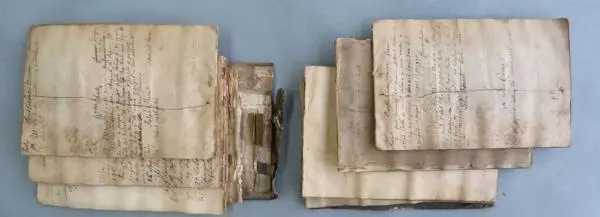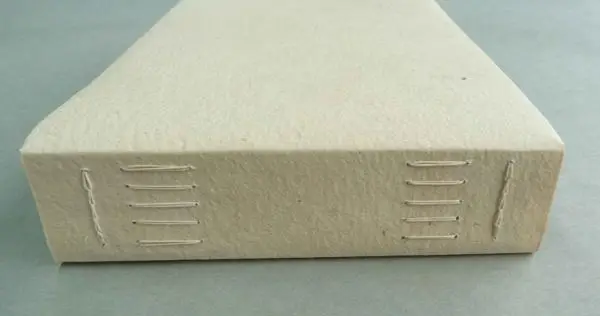Conservation in Action: A Foundling Hospital Prescriptions Book
From Coram’s Foundling Hospital archives
The Foundling Hospital was the first dedicated children’s charity in the UK and has a rich history spanning over 275 years and recorded in a large archive touching the lives of 25,000 children. The medical records of the Hospital provide a detailed and complete account of the health and medical treatment of the children from the 18th to the 20th centuries. The records are already catalogued online; however, many were marked as unfit for consultation by the public because of their poor condition.
In 2015 London Metropolitan Archives conservators carried out a survey to assess the condition of the volumes and bundles which made up the medical records. The survey identified that 124 items required conservation treatment on different levels. Most of the items were unfit and not accessible to users because they had been damaged by a legacy of extensive handling and inappropriate storage. In 2016 LMA secured funding from the Wellcome Trust’s Research Resources in Medical History scheme to preserve and conserve the items and to digitise them to minimise handling and to create an accessible online resource. The conservation project started in May 2017 and was completed in February 2018.
Conserving the prescriptions book
The project was shared between two conservators, Giorgia Genco and Lara Speroni, who were working in close collaboration, sharing and discussing methodologies and treatment options. A minimal intervention approach was applied to preserve all the original features of the items, whilst ensuring that they can be handled safely in future.
The volumes are bound in different styles, using a range of materials, such as leather and parchment. They differed in their physical condition and extent of damage, from fit to unfit for consultation and, in some cases, not suitable for digitisation.
Here Giorgia Genco discusses the challenge of conserving a badly damaged volume, part of the 'Prescriptions day book' series and dated 1762-1794 (A/FH/A/18/ 006/007).

The volume was bound in a full stiff vellum binding (dimensions are 144 x 204 x 53 mm). The textblock consisted of eleven sections, sewn on two parchment tapes, each tape split into three tongues, of which the two narrowest were laced through the cover. The document is handwritten with iron gall inks on handmade laid paper.
The manuscript was in extremely poor condition. Surface and ingrained dirt was present all over the cover and throughout the textblock. The cover was detached from the textblock and broken along the spine, which was partially missing. The boards were distorted and severely damaged by water and mould. The sewing supports were broken and partially missing. All the sections were loose, and the sewing was broken in many areas.
The textblock was in bad condition: four sections were inaccessible as their leaves were stuck together as a result of water and mould damage. The same problem was found in the last section, the pages were stuck on each other and to the back board. The writing support was fragile and weak, with many losses and tears throughout. Some leaves were so soft and damaged that handling would have caused further damage.
The iron gall inks were faded and unstable in some areas because of the exposure to high relative humidity and direct contact with water. A test, which was positive, was carried out to detect the presence of iron(II) ions which are responsible for the degradation of the ink and the writing support.
Two types of intervention were necessary to strengthen the textblock and the cover: chemical stabilisation and physical consolidation of the pages, including the media. The first step was removing the surface dirt which, if not removed, can provide a food resource for insects and mould and accelerate the degradation within the fibres of the papers. The cleaning was performed by means of a latex vulcanised sponge. A soft brush was used on the areas where the writing support was more fragile.

The next stage was to remove and neutralise the acidity in the paper. This operation also improves the flexibility of the writing support. The textblock was immersed in a bath of deionised water which removes the soluble acidity. The bath was then followed by a wash in calcium phytate which should improve the stability of the iron gall inks used in this manuscript and avoid chemical degradation of the paper. A final wash in a deacidification solution of calcium bicarbonate was carried out to neutralise the remaining acidity; the salts of this solution provide a buffer for future acidity formation within the paper fibres.
The textblock was then left to dry between felts interleaved with Bondina, a non-stick polyester. The paper was then resized with a solution of 2% gelatine in water applied with a brush to give extra strength to the support.
Once the chemical stabilisation was completed, the pages needed mechanical consolidation so losses, soft areas of the paper and tears were repaired with Japanese paper of different thicknesses according to the type of damage and thickness of the original paper. Wheat starch paste was used as adhesive.
The original cover was too damaged to be reused because it was beyond repair. A non-adhesive binding was chosen as a good solution to protect and preserve the textblock. The sewing is unsupported and all the sections are sewn together with the cover. This type of binding is very flexible, easy to handle and allows safe digitisation.

The book and the original cover were housed in a bespoke clam shell box made of conservation grade board, which offers protection against dust, light and environmental fluctuations.
See also Genco, Giorgia The benefit of (not) sticking together: a non-adhesive binding solution for The Book and Paper Gathering (2021).
Further conservation on the Foundling Hospital archives
In 2019 Coram was awarded a grant from the National Lottery Heritage Fund for Voices Through Time: The Story of Care to digitise over 100,000 items from the archive, transcribe them and make them accessible online. Project conservators Rosemary Coppell and Wanda Robins based at LMA have been preparing the items for digitisation and you can read more about this, as well as about the subsequent digitisation at LMA, on the Coram Story blog.
The Foundling Hospital archive is owned by the charity Coram, undertaking pioneering work in adoption, early years and parenting from the original London site of the Foundling Hospital. You can explore the history of the Foundling Hospital further and even volunteer for the online project to transcribe its archives through the Coram Story website.